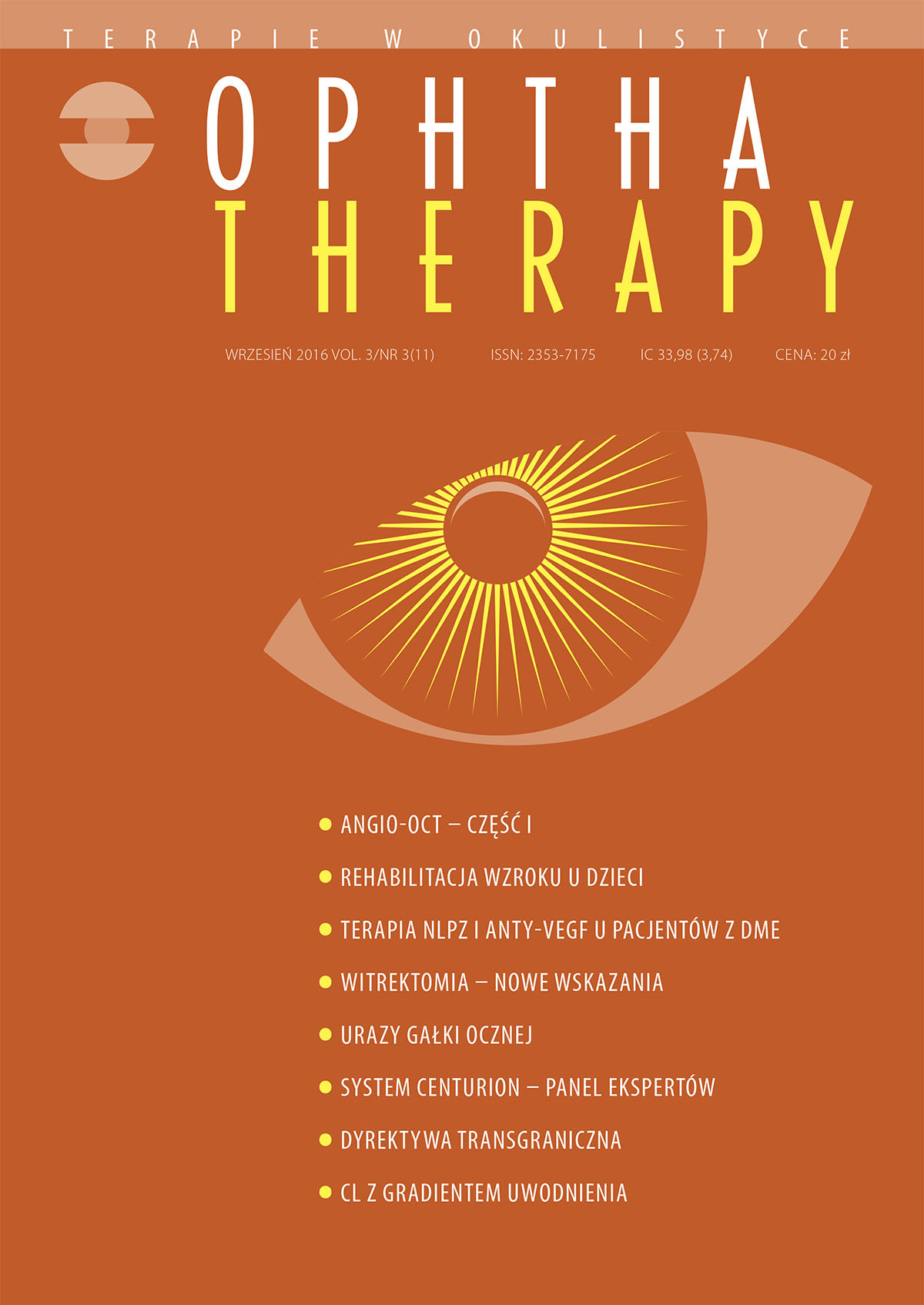Współczesne strategie chirurgicznego leczenia ciężkich urazów gałki ocznej
##plugins.themes.bootstrap3.article.main##
Abstrakt
Postępowanie przy podejrzeniu urazu gałki ocznej początkowo nie odbiega od stosowanego w innych chorobach okulistycznych. Dopiero po postawieniu wstępnego rozpoznania należy zaplanować strategię leczenia. Trzeba wziąć przy tym pod uwagę stan ogólny, stan oka i możliwość jego zachowania. W przypadku witrektomii preferowana jest technika małego cięcia. Gdy istnieje podejrzenie ciała obcego wewnątrzgałkowego, należy wykonać badania obrazowe. W przypadku urazu obejmującego całą gałkę oczną ośrodki optyczne tracą swoją przezierność i uniemożliwiają wgląd w dno oka oraz postawienie pełnej diagnozy i przeprowadzenie leczenia. Dysponujemy wówczas kilkoma rodzajami postępowania: zabiegiem odroczonym, operacją open sky, chirurgią endoskopową oraz zabiegiem z keratoprotezą czasową. 7% urazów otwartych gałki ocznej wiąże się z rozwojem jej zapalenia. Strategia postępowania w przypadku późnego (zaawansowanego) zapalenia wewnątrzgałkowego polega na wykonaniu pilnej witrektomii.
Pobrania
##plugins.themes.bootstrap3.article.details##

Utwór dostępny jest na licencji Creative Commons Uznanie autorstwa – Użycie niekomercyjne – Bez utworów zależnych 4.0 Międzynarodowe.
Copyright: © Medical Education sp. z o.o. License allowing third parties to copy and redistribute the material in any medium or format and to remix, transform, and build upon the material, provided the original work is properly cited and states its license.
Address reprint requests to: Medical Education, Marcin Kuźma (marcin.kuzma@mededu.pl)
Bibliografia
2. Kuhn F, Mester V, Berta A et al. Epidemiology of severe eye injuries. United States Eye Injury Registry (USEIR) and Hungarian Eye Injury Registry (HEIR). Ophthalmologe. 1998; 95(5): 332-43.
3. Casson RJ, Walker JC, Newland HS. Four-year review of open eye injuries at the Royal Adelaide Hospital. Clin Experiment Ophthalmol. 2002; 30(1): 15-8.
4. Liggett PE, Pince KJ, Barlow W et al. Ocular trauma in an urban population. Review of 1132 cases. Ophthalmology. 1990; 97(5): 581-4.
5. Katz J, Tielsch JM. Lifetime prevalence of ocular injuries from the Baltimore Eye Survey. Arch Ophthalmol. 1993; 111(11): 1564-8.
6. Sinclair SA, Smith GA, Xiang H. Eyeglasses-related injuries treated in U.S. emergency departments in 2002–2003. Ophthalmic Epidemiol. 2006; 13(1): 23-30.
7. Parker JF, Simon HK. Eye injuries due to paintball sports: a case series. Pediatr Emerg Care. 2004; 20(9): 602-3.
8. Kuhn F, Morris R, Witherspoon CD et al. A standardized classification of ocular trauma. Ophthalmology. 1996; 103(2): 240-3.
9. Kuhn F, Zagórski Z, Bielińska A. Urazy oka. Czelej, Lublin 2011: 5, 39, 184-5, 198.
10. Brinton GS, Aaberg TM, Reeser FH et al. Surgical results in ocular trauma involving the posterior segment. Am J Ophthalmol. 1982; 93(3): 271-8.
11. De Juan E, Sternberg P, Michels RG. Penetrating ocular injuries. Types of injuries and visual results. Ophthalmology. 1983; 90(11): 1318-22.
12. Kuhn F, Maisiak R, Mann L et al. The Ocular Trauma Score (OTS). Ophthalmol Clin North Am. 2002; 15(2): 163-5.
13. Nowomiejska K, Haszcz D, Forlini C et al. Wide-Field Landers Temporary Keratoprosthesis in Severe Ocular Trauma: Functional and Anatomical Results after One Year. J Ophthalmol. 2015; 2015: 163675. https://doi.org/10.1155/2015/163675.
14. Brackup AB, Carter KD, Nerad JA et al. Long-term follow-up of severely injured eyes following globe rupture. Ophthal Plast Reconstr Surg. 1991; 7(3): 194-7.
15. Rofail M, Lee GA, O’Rourke P. Quality of life after open-globe injury. Ophthalmology. 2006; 113(6): 1057.e1-3.
16. Unver YB, Acar N, Kapran Z et al. Prognostic factors in severely traumatized eyes with posterior segment involvement. Ulus Travma Acil Cerrahi Derg. 2009; 15(3): 271-6.
17. Lewandowski B, Brodowski R, Dymek M et al. Obrażenia oczodołu powikłane obecnością ciała obcego. Okulistyka. 2010; 4: 34.
18. Kuhn F, Mester V, Morris R. A proactive treatment approach for eyes with perforating injury. Klin Monatsblätter für Augenheilkd. 2004; 221(8): 622-8.
19. Chorągiewicz T, Nowomiejska K, Wertejuk K et al. Surgical treatment of open globe trauma complicated with the presence of an intraocular foreign body. Klin Oczna. 2015; 117(1): 5-8.
20. Cleary PE, Ryan SJ. Mechanisms in traction retinal detachment. Dev Ophthalmol. 1981; 2: 328-33.
21. Prost M. Chirurgia witreoretinalna w chorobach oczu u dzieci. Okulistyka. 1999; 2(3): 22-6.
22. Garcia-Valenzuela E, Blair NP, Shapiro MJ et al. Outcome of vitreoretinal surgery and penetrating keratoplasty using temporary keratoprosthesis. Retina. 1999; 19(5): 424-9.
23. Boscher C, Kuhn F. An endoscopic overview of the anterior vitreous base in retinal detachment and anterior proliferative vitreoretinopathy. Acta Ophthalmol. 2014; 92(4): e298-304.
24. Mamalis N. Endophthalmitis. J Cataract Refract Surg. 2002; 28(5): 729-30.
25. Morris RE, Witherspoon CD, Feist RM et al. Infectious endophthalmitis: an ocular emergency. Ala Med. 1986; 56(5): 18-20, 25-6.
26. Essex RW, Yi Q, Charles PG et al. Post-traumatic endophthalmitis. Ophthalmology. 2004; 111(11): 2015-22.
27. Kernt M, Kampik A. Endophthalmitis: Pathogenesis, clinical presentation, management, and perspectives. Clin Ophthalmol. 2010; 4: 121-35.
28. Kuhn F, Gini G. Ten years after... are findings of the Endophthalmitis Vitrectomy Study still relevant today? Graefe’s Arch Clin Exp Ophthalmol. 2005; 243(12): 1197-9.
29. Mackiewicz J, Kozioł-Montewka M, Kosior-Jarecka E et al. Evaluation of antimicrobial properties of silicon oil – in vitro studies. Klin Oczna. 2004; 106(3 Suppl): 434-5.
30. Ozimek M, Nowomiejska K, Forlini C et al. Posttraumatic endophthalmitis due to tobacco drying wire treated with vitrectomy, temporary keratoprosthesis, and keratoplasty. Ophthalmol J. 2016; 1(1): 36-9.

